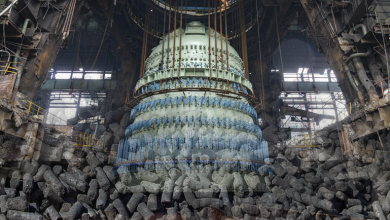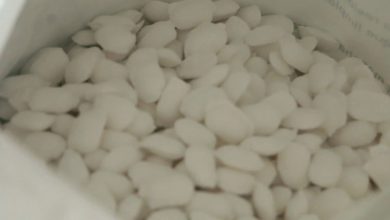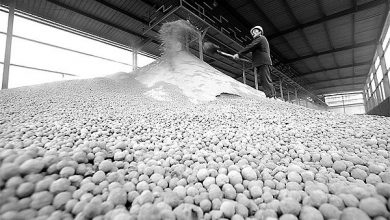How is coal generated?
Coal is a kind of fossil fuel. It is plant residues (sometimes containing some animals) that have been buried in the deep underground. (including biochemical action, diagenesis, metamorphism), transformed into a combustible solid mineral.
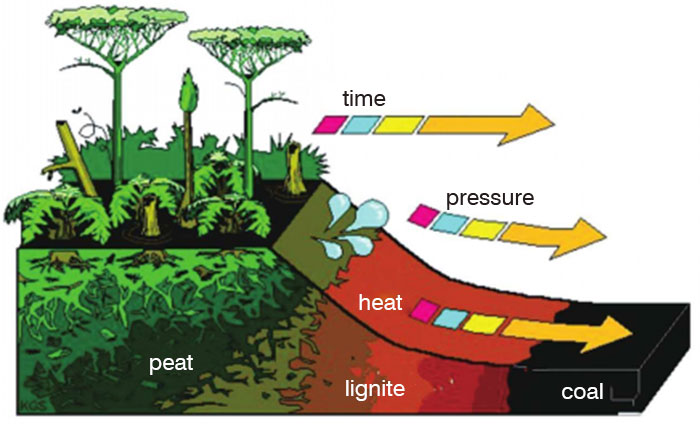

Why make coal briquette
During coal mining, transportation, and processing (crushing, grinding, or pulverizing), a lot of coal fine and coal dust will be produced, especially in modern mining operations, advanced equipment will lead to more coal dust. It is a very good recycling method to make these dusts into briquettes.
In some industrial production, due to the regularity of the shape and size of the coal, the physical and chemical characteristics of the coal have certain requirements, when the lump coal cannot meet these requirements well, using coal briquette becomes a better choice.
The history of coal briquetting
The production of coal briquette first started from civilian use. It was invented in China more than 2,200 years ago. Cylindrical briquettes with a diameter of about 16 cm and a height of 8 cm were found in the ironmaking site of the Western Han Dynasty.

As early as the 18th century, people used loess as a binder to make coal briquettes, coal brick or coal cake by hand as civil fuel. In the 1840s in Europe, coal granulation had already begun by using fine coal. In France and England, briquettes have been granulated from fine-grained hard coal, to which flammable binding substances are added. In Germany, a new coal briquette production method was created, that is, without using any binder, and use appropriate high-volatile peat and lignite to produce coal briquette. As a result, two unrelated fine coal briquetting techniques developed: in England and France, the binder briquetting of hard coals. But in Germany, the binder free briquetting of peat and soft lignite. At this point, the briquette technology in the modern sense came into being.
Coal briquette uses
Coal is called “the grain of industry”. It is an indispensable energy source for industry, agriculture and people’s life, and an important raw material for metallurgy, chemical industry, medicine and other departments.
In our daily life, many households widely use coal briquettes for the cooking, space, and water heating purposes.
In industrial production, briquette has the following uses in industrial production
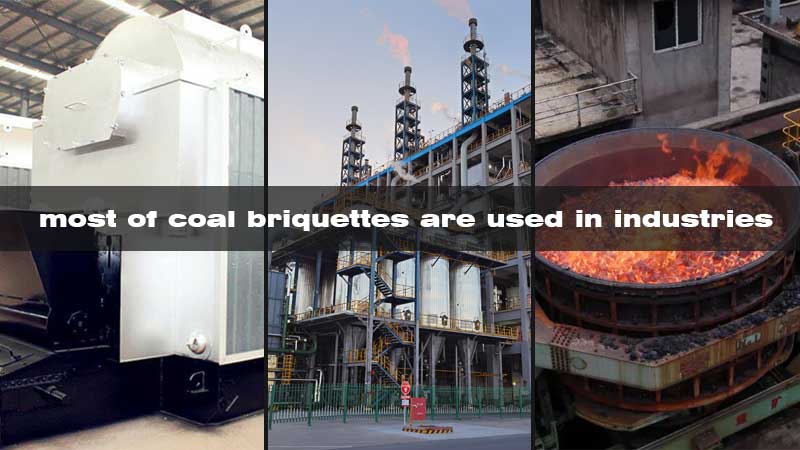
Fuel
Industrial boilers, industrial kilns (foundry furnaces, forging furnaces, flame furnaces, steel rolling heating furnaces, etc.), steam locomotives (railway steam locomotives, marine steam locomotives)
Gasification
Industrial gas, synthetic ammonia and other chemical fertilizer gas production, etc.
Smelting
After coking, it can be used for ironmaking, manganese smelting, etc., sometimes directly use the briquette.
Are coal briquettes better than lump coal
Briquette mainly uses coal fine and coal dust with relatively low combustion efficiency to transform it into a fuel with a fixed shape and higher calorific value. When the coal is used for civil purposes, the thermal efficiency of lump coal is 10%, while the round coal briquette is 20%, and the thermal efficiency of honeycomb coal briquette is 30%.
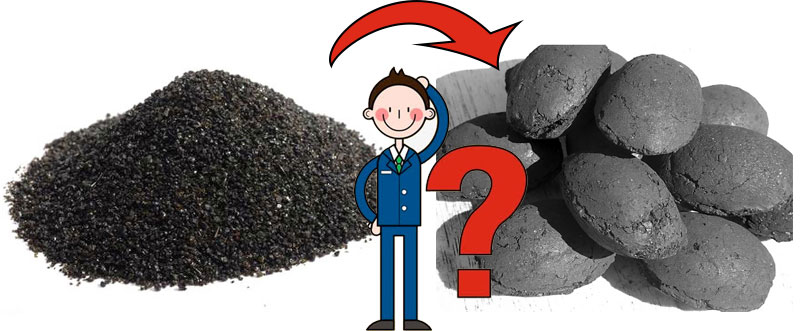
Compared with lump coal, coal briquette has the following advantages:
- Regular shape: the coal briquette has regular shape, homogeneous properties, and uniform particle size, which is incomparable to natural lump coal. This facilitates application in production.
- Large porosity: briquettes are formed by pressing coal fine or coal dust through a powerful force of the coal briquetting machine, so the porosity of the briquettes is significantly larger than that of natural lump coal, which is more conducive to full combustion.
| Coal type | Porosity | |
| lump coal | coal briquette | |
| Anthracite | 3 | 12.5 |
| Bituminous | 5 | 17.5 |
- High reactivity: compared with lump coal, coal briquette has significantly higher reactivity.
- Good combustion characteristics: compare to lump coal, coal briquette has long burning time, high calorific value, sufficient combustion, less ash, long fire sealing time, fast ignition, high flame, and stable combustion state.
- Small environmental hazards: the sulfur dioxide produced in the combustion of coal briquette with good formula is converted into sulfur trioxide and solidified in the furnace ash after adding oxygen. The carbon monoxide produced in combustion produces carbon dioxide after adding oxygen, which turns into water gas and methane gas after heating up, so that the briquette can be fully burned, which not only increases the furnace temperature but also increases the thermal efficiency, and realizes turning harm into benefit and turning waste into wealth.
- Briquette made by the coal briquette machine is easy to transport and store: regular shape and size, high molding strength, not easy to break during transport and storage, and avoid pollution to the living environment.
- Coal briquette has changed the physical and chemical properties of raw coal in a targeted manner: briquette can play a significant role in reducing viscosity, melting resistance, Improved reactivity, thermal stability, mechanical strength, and sulfur fixation and other modification and optimization effects.
Coal briquettes manufacturing process
Coal briquette making can be divided into the following steps:
Raw material preparation—crushing (if needed)—mixing—briquetting—drying
- Raw material preparation: create a favorable foundation for coal briquette making. Material needed includes raw coal, high carbon material, binder, additives like lime, etc.
- Crushing: It is better to control the coal to size under 3mm, a well distributed size can help to improve the quality of briquette and the performance of the system.
- Mixing: Add a certain proportion of binder and water and other required additives along with coal fine or dust and mixing well to achieve a good distribution, make sure the surface of coal particles is wetted by binder and water.
- Briquetting: transport the even mixture into the coal briquette making machine for molding. The common molding equipment includes roll briquetter, extruder, disc pelletizer, and the coal briquettes made by briquette machine are normally around 30-60mm.
- Drying: Dry the fresh briquette naturally or in a dryer.
The binder for coal briquette making
The binders for coal briquette can be divided into the following categories according to their properties:

Inorganic binder
Such as water glass, clay, lime, kaolin, bentonite, cement, clay, gypsum and inorganic salts like sodium chloride, etc. These binders are cheap, have a certain bonding strength, and some components contained in them can also react with sulfur in coal to play a role in sulfur fixation.
organic binder
Organic binder normally has better bonding performance, less residual ash after burning, can burn partly or completely by itself, and has a certain calorific value.
Like biomass binders, such as dried corn cobs and their stems, sugar beet chips, sunflower stems, lignin, xylose, as well as starch, potato, flour, etc. They not only have better calorific value, but also do not increase the ash content of coal briquettes.
Industrial and agricultural waste. e.g., potato waste residue, pulp waste liquid, leather and chemical plant waste, waste starch, fatty acid residue, furfural residue, biological sludge, sugar waste liquid, molasses, sulfurous acid waste residue from fiber factories, etc. This kind of binder can realize the recycling of waste and reduce environmental pollution.
How to choose a suitable binder
When we choose the binder for coal briquetting, we need to follow the below rules:
- Strong bonding ability, good fluidity, easy diffusion and uniform distribution on the surface of coal particles
- The binder doesn’t or slightly increase the ash content in the briquette and better doesn’t reduce the calorific value
- Better it can make the coal briquette have good water resistance. (no water absorption)
- Easy to be prepared
- Abundant source, economic, no secondary pollution


